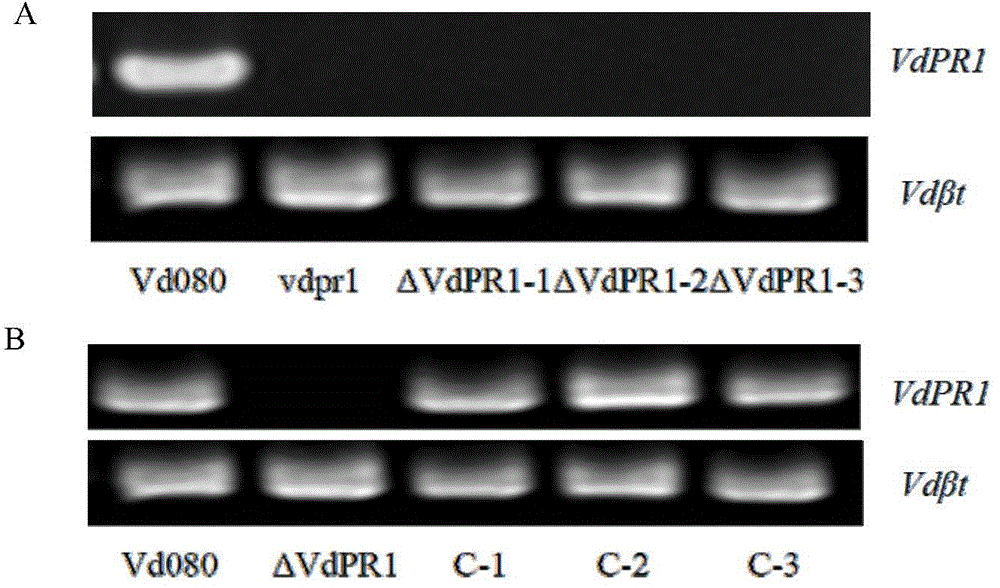Applications of verticillium dahlia pathogenicity related gene VdPR1 as anti-verticillium dahlia target gene
A technology for cotton Verticillium wilt bacteria and disease-related genes, which is applied in the fields of application, genetic engineering, plant genetic improvement, etc., can solve the problem of limited research reports on the molecular mechanism of disease, disease control methods and drugs are difficult to achieve control effects, no control methods, etc.
- Summary
- Abstract
- Description
- Claims
- Application Information
AI Technical Summary
Problems solved by technology
Method used
Image
Examples
Embodiment 1
[0023] Example 1: Isolation and cloning of the VdPR1 gene
[0024] Through the pathogenicity determination of the T-DNA insertion mutant library of the strong pathogenicity cotton Verticillium dahliae strain Vd080 (preservation number: CGMCC No.5904), the mutant vdpr1 with significantly reduced pathogenicity was screened. Southern hybridization confirmed The mutant is a single-copy insertion of T-DNA, and the disease-related gene VdPR1 is obtained by using TAIL-PCR and the VdLs.17 genome database.
[0025] 1.1 Southern hybridization to determine the copy number of mutant vdpr1 T-DNA insertion
[0026] The Southern hybridization probe primer HygP-F / R was designed according to the hygromycin fragment sequence with a size of about 500 bp on T-DNA. Genomic DNA of low pathogenicity mutant vdpr1 5ng, NEB buffer 10μL, BamHI 3μL, water up to 100μL. Digest for 5 hours at 37°C, and then bathe in water at 65°C for 10 minutes to terminate the digestion reaction. The methods of probe pr...
Embodiment 2
[0034] Embodiment 2: Construction of VdPR1 gene knockout vector and complementary vector
[0035] 2.1 Construction of knockout vector
[0036] Firstly, the conventional PCR method was used to amplify the upstream 1.2 kb sequence and the downstream 1.2 kb sequence of the VdPR1 gene from the genome of wild-type Vd080 with primers P1 / P3 and P4 / P6 respectively, and the plasmid pUC- A 1.8kb hygromycin resistance gene cassette sequence was obtained from Hyg, wherein primers P3, P4 and HPH-F, HPH-R have reverse complementary linkers. Then combined with the fusion PCR technology, the upstream fragment, the hygromycin resistance gene cassette and the downstream fragment were fused according to 1:3:1 to obtain the fusion product of the upstream-hygromycin-downstream fragment. Secondly, the nested PCR method was used to amplify the three-fragment fusion product with specific primers P2 and P5 with Gateway BP reaction adapters. Finally, this fragment was integrated into the pGKO2-Gatewa...
Embodiment 3
[0039] Example 3: Obtaining of VdPR1 Gene Knockout Mutants and Complementary Mutants
[0040] 3.1 Obtaining knockout mutants
[0041] The knockout vector pGKO-VdPR1 was transformed into Agrobacterium AGL-1 by freeze-thaw method for the genetic transformation of the wild-type strain Vd080, and the concentration of the spore liquid of Verticillium dahliae Vd080 was adjusted to 5×10 6 Mix CFU / mL and Agrobacterium AGL-1 (OD=0.3–0.4) in equal volumes, take 200ul of the mixture and spread it on a microporous membrane that is spread on IM medium (200μmol / L AS), and incubate at 25°C cultured in the box for 2 days. Transfer the above microporous filter to PDA selection medium (50 μg / mL Cef, 50 μg / mL Spe, 50 μg / mL Hyg and 50 μmol / L F 2 dU) and cultured at 25°C for more than 5 days until colonies of transformants appeared. Pick a small amount of mycelium with a toothpick and add it to 200ul sterile water to prepare a spore suspension, and apply WA (Cef, Spe, Hyg, F 2 dU) plate, culti...
PUM
 Login to View More
Login to View More Abstract
Description
Claims
Application Information
 Login to View More
Login to View More - R&D
- Intellectual Property
- Life Sciences
- Materials
- Tech Scout
- Unparalleled Data Quality
- Higher Quality Content
- 60% Fewer Hallucinations
Browse by: Latest US Patents, China's latest patents, Technical Efficacy Thesaurus, Application Domain, Technology Topic, Popular Technical Reports.
© 2025 PatSnap. All rights reserved.Legal|Privacy policy|Modern Slavery Act Transparency Statement|Sitemap|About US| Contact US: help@patsnap.com



